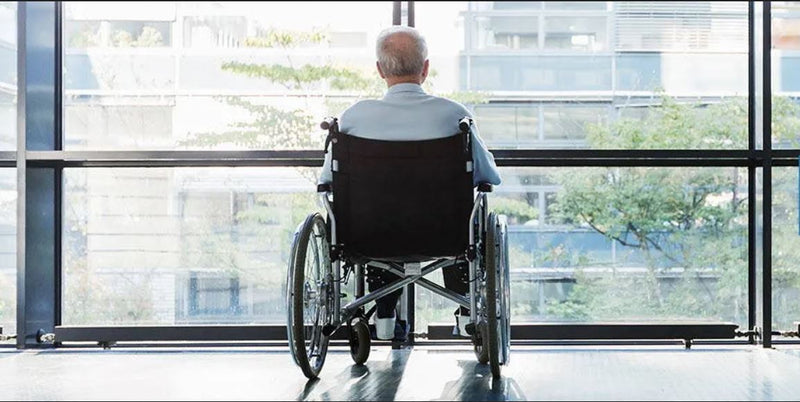Caregivers Corner
Understanding Elder Abuse and Neglect

Elder abuse is a serious subject that not many people are aware of today. When we think of older adults, we think of people who are wise, caring, and sweet. Thoughts of the older generation being abused is the last thing that may come to mind, but elder abuse is more prevalent than one may think.
What is Elder Abuse?
Elder abuse is defined as abuse towards a person that is aged 65 years or older and can be considered both a criminal and civil offense. The victims of elder abuse vary as well; it affects both men and women and people of all backgrounds and status. Since elder abuse can be domestic (the senior has a personal relationship with the abuser) or institutional (abuse in a care facility), it is important to know that perpetrators could be anyone, from family, to spouses, and nursing home staff.
Note: The elder abuse statistics presented are estimates due to the number of victims who are fearful or unable to report the abuse. As a matter of fact, according to a study by the National Academy of Sciences and DHHS/National Institutes of Health, only 1 in 14 elder abuse cases are reported.
Types of Elder Abuse?
There are multiple types of abuse that an older adult may experience. They may also be affected by one or more types. Being aware of the multiple types of elder abuse is beneficial in recognizing when an elder person is in need of assistance.
Physical Abuse
Physical elder abuse is the use of any sort of physical force that inflicts harm or pain to an older adult, such as hitting, shoving, or kicking.
Emotional/Psychological Abuse
Emotional/Psychological elder abuse is the use of verbal and non-verbal (psychological) acts to cause pain or distress, such as threats, yelling, humiliation, isolating, and terrorizing.
Neglect/Abandonment
Senior neglect is the act of intentionally or unintentionally failing to provide necessary care taking duties, such as not providing food, housing, or medical attention. Abandonment, within the same category as neglect, is the act of deserting the older adult and ceasing any duties of care.
Financial Abuse
Financial elder abuse is the act of using an elderly person’s money or property without permission. This includes stealing, misuse of financial accounts, or identity theft.
Sexual
Sexual elder abuse includes any sexual contact with an elderly person without their consent. This includes sexual assault, unwanted touching, forcing pornographic material, or taking pictures of them while nude.
What Elder Abuse Looks Like - Statistics from National Center on Elder Abuse, Bureau of Justice Statistics.

Elder Americans Abused
The number of elderly persons in America is constantly climbing. According to the U.S. Census, the number of elders in America is 47.8 million, as of July 1, 2015. It is estimated that there will be 98.2 million elderly people in the U.S. by the year 2060. With the number of seniors rising, the number of elder abuse cases will rise if awareness of the issue isn’t surfaced.

Perpetrators of Elder Abuse
People who abuse the elderly can be anyone, whether that’s a family member, spouse, or somebody that has been entrusted to care for the elderly. Statistically, elder abuse perpetrators are more likely to be male family members of the victim that have a history of issues like substance abuse and financial problems. According to the National Council on Aging, roughly 60% of elder abuse perpetrators are family members, which include adult children, partners, and spouses.

Although a majority of perpetrators are family members, we shouldn’t dismiss that elder abuse happens in nursing homes and long-term care facilities as well. Based on a study conducted by the World Health Organization, it is apparent that elder abuse also thrives in nursing homes.
- 36% of nursing home staff in the U.S. have witnessed physical elder abuse at least once.
- 10% have committed physical elder abuse at least once.
- 40% have admitted psychological elder abuse towards patients.
- Women are six times more likely to be sexually abused than elderly men, and the majority of these cases occur in nursing homes or other facilities.
Effects of Elder Abuse
Physical Abuse
The impact of physical abuse on older adults includes injuries (lacerations, broken bones, head injuries, bruises, wounds, etc.), sleep disorders, soreness, nutrition problems, increased risk of premature death, and more. Any level of elder abuse contributes to a 300% higher risk of death, compared to those not abused. Also, there is an estimated $5.3 billion in medical costs due to elder abuse injuries.
Emotional/Psychological Abuse
The impact of emotional/psychological abuse includes distress, depression, and declines in mental health.
Neglect/Abandonment
Neglecting and abandoning an elderly person in need of care also contributes to a higher risk of death, as well as a number of health-related problems.
Financial Abuse
Financial abuse causes economic losses and affects not only the elderly, but businesses, families, and government programs. This type of abuse equates to about $2.6 billion dollars of seniors’ money lost, annually.
Sexual Abuse
Similar to emotional/psychological and physical abuse, sexual abuse has a multitude of effects on the an elderly victim including depression, flashbacks, and PTSD.

How to Identify and Report Elder Abuse
There are multiple indicators that can be observed to help identify if an elderly person is experiencing abuse. Recognizing that an elderly person is being abused can help stop that abuse sooner, so that they can recover and the abuser can be dealt with by the law.
Physical Abuse and Neglect Indicators
- Unusual loss of weight
- Visible bedsores, bruises, or skin damage
- Looks malnutritioned and/or dehydrated
- Pain gestures when moving or touched
Behavioral Indicators
- Anger
- Anxiety
- Confusion
- Depression
- Fear
- Helplessness
- Non-Responsive
- Withdrawal
Abusive Indicators (Relatives or Caregivers)
- Speaking for the elder person when they are capable of doing so themselves
- Conflicting stories between the caregiver and elder person
- Substance abuse is apparent in the caregiver
- Restricting activity or socially isolating the elder person
Preventing Elder Abuse
The best way to prevent elder abuse as an outsider is to be aware of what elder abuse is and recognize it through warning signs. This way, if any senior exhibits any of these signs, it can be reported and stopped.
As for seniors, there are a number of actions they can take to stay safe. The following are some things that seniors can do to prevent abuse:
- Maintain a positive, active, and healthy lifestyle to decrease the chances of being vulnerable to abuse.
- Encourage and seek assistance for any family members that are experiencing substance abuse or abnormal behavior (depression, social isolation, etc).
- Actively monitor all of their financial accounts.
- Utilize a living will to specify any healthcare decisions for the future.
- Review their will periodically to make sure any unauthorized changes haven’t been made to it.
- Safely guard personal information by not giving personal info on the phone, posting/opening all mail, etc.
- Have full knowledge of personal rights and voice opinions when necessary.
If you or someone you know is experiencing elder abuse, contact your local Adult Protective Services office, Ombudsman, or local authorities as soon as possible. MobileHelp medical alert systems can also assist by contacting a trusted neighbor, family member, or emergency services. If you or the suspected victim is in immediate, life threatening danger, call 911.
Sources
https://www.census.gov/newsroom/facts-for-features/2017/cb17-ff08.html
https://www.ncoa.org/public-policy-action/elder-justice/elder-abuse-facts/
https://www.statisticbrain.com/elderly-abuse-statistics/
http://canhr.org/factsheets/abuse_fs/html/fs_elderabuse.htm
http://www.who.int/mediacentre/factsheets/fs357/en/
http://www.healthinaging.org/resources/resource:preventing-elder-abuse-and-neglect-in-older-adults/
https://ncea.acl.gov/whatwedo/research/statistics.html









